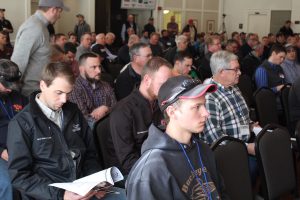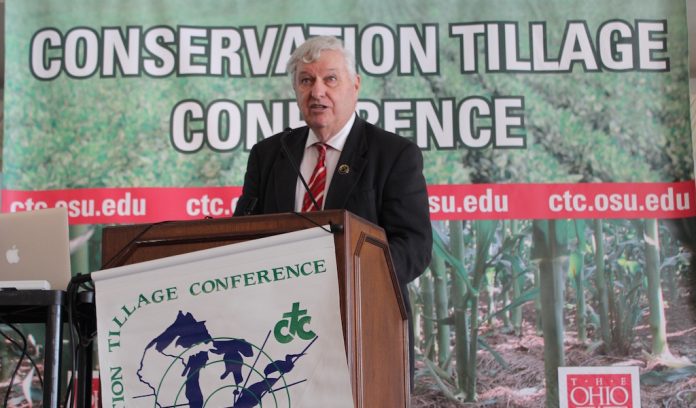ADA, Ohio — Soil health continued to be the major focus at this year’s Conservation Tillage and Technology Conference, held March 6-7 at Ohio Northern University.
Although yield and return per acre is still the goal, farmers were reminded that their growing season begins by taking care of the soil.

David Montgomery, an author and professor of earth and space sciences at the University of Washington, said farmers only lose a small portion of their soil each year — about 1.5 millimeters.
But that trend is not sustainable for long, he said, noting that soil degradation “is one of the really big challenges that humanity faces in the 21st century.”
Losing money
Montgomery said soil loss is like losing money — you might be OK for a while — but eventually it starts to hurt.
“If you spend money faster than you make it, for long enough, you go broke,” he said. “Soil is no different as a system. If we erode it faster than we’re building it, then we run out.”
Montgomery, who has authored several books about soil health, is not opposed to farming, but said some things need to change.
“The problem isn’t that we farm; the problem is the way we’ve been farming,” he said.

The 900 or so farmers and crop advisers who attended the conference heard about the importance of cover crops, no-till, and manure management — all as ways to help improve soil health.
During an afternoon talk on manure management, Kevin Elder, chief of the Division of Livestock Environmental Permitting for the Ohio Department of Agriculture, talked about the issues he’s seeing on Ohio’s livestock farms.
Doing better
Overall, he said more manure is applied better each year, and in accordance with the needs of crop production.
He received 24 complaints against permitted facilities last year, and only 9 were valid. He reminded producers that they need to keep up on the current manure application laws, and they need to know where those nutrients are going — even post application.
The state’s definition of “agricultural pollution” basically covers the degradation of any water leaving the farm, he explained. He also reviewed the requirements of S.B. 1 — the law which set new manure application standards in the western basin of Lake Erie.
Farmers in that area are prohibited from applying manure to frozen or snow-covered ground, and must not apply when there is greater than a 50 percent chance of a half-inch rain event within 24 hours.
The law provides certain exclusions, such as if the manure is being applied to a “growing crop,” or injected beneath the surface or incorporated into the soil. But those exceptions have certain requirements. For instance, a “growing crop” needs to be one that will not winter-kill, Elder said, and it must have a reasonable extent of ground cover.
Common sense
He said his staff is not going to count blades of grass to determine if the ground is truly covered — but it should be obvious to the farmer.
Likewise, farmers who choose to “incorporate” manure into the soil need to do more than just poke holes in the ground. The goal of incorporation is soil-to-nutrient contact.
What it comes down to, Elder said, is using common sense. And when possible, he said farmers should also keep good records, especially of the forecast.
“If in doubt, don’t do it,” he said. If it doesn’t feel right, ask somebody else for advice.”
Manure management is even more challenging when we have the kind of extreme rain events we’ve experienced the past few years.
Aaron Wilson, a climate change expert with Ohio State University, said the state is seeing an increase in heavy precipitation, especially in the fall months. According to climate models, the state is facing 3-4 more inches of rain per year than in the past.
“It’s not falling gently,” he said. “It’s not evenly distributed throughout the year.”
Nutrient runoff
And those heavy rains are having a big impact on nutrient runoff — a fact farmers and scientists both observe.
“The precipitation we’re having has an impact on Lake Erie,” Wilson said. “These extreme weather events are part of this story.”
Elder said there were multiple reports of fish kills last August, after heavy rains washed manure into streams. He said a fish kill can easily cost a farmer several thousand dollars, even when all the rules are followed.
He said it’s a good idea for farmers to keep an eye on fields were manure has already been applied — at least through the first rain event.
“That manure can get into that water flow and come out the outlet, so be aware of what’s going on,” he said.
Elder, who is set to retire from ODA in a month, said it grieves him that farmers can follow all the rules and do everything correctly, but still be held liable.
He said some people would like to see a 100 percent guarantee of no farm impact to waters of the state — something he doesn’t believe is practical.
“That is almost impossible to guarantee with mother nature,” he said. “It’s not even possible with sanitary sewers and storm sewers yet; I don’t know how they would do it with fields.”
If he had his wish list, it would include that when farmers do everything correctly, “that we don’t penalize for what cannot be controlled.”
Master farmers
Keeping with tradition, this year’s conference honored two Master Farmers who represent the best in crop production, soil conservation and stewardship.
Dale Profit, of Van Wert County, has farmed for more than 50 years. Today, he grows popcorn, seed beans and wheat. Gary Shick, of Hardin County, grows corn and soybeans and started no-till farming in 1969.
Both farms are multi-generational family operations, with a focus on the future and improving soil health.
The Ohio Certified Crop Adviser of the Year went to John Fritz, of Fremont, Ohio.











G’day, the above also applies to livestock producers(or should) as nutrient load loss is a loss of “profit”(IMO).
Here in “downunder”a major input cost is that of fertilizer so why would you allow all that natural fertilizer to run down the paddock and into the local creek?